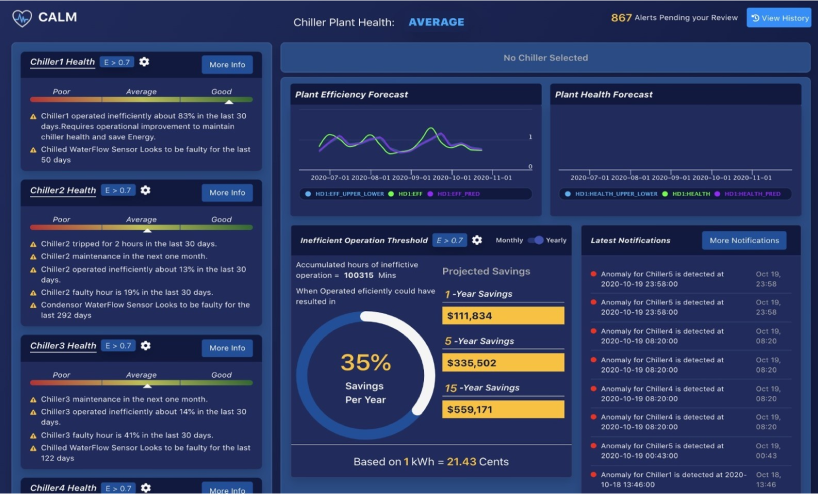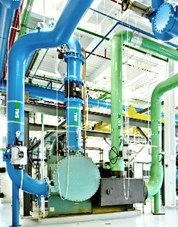September 25, 2021
Reviewed by : King Wan Eco Solutions Pte Ltd.
The COVID-19 crisis has induced reduction in revenue and increase in operating expenses to most sectors due to “new normal” compliance requirements, like Social Distancing (reduced seat capacity), Travel Restrictions (higher labour costs), and personnel identity and temperature monitoring (additional labour), etc.
Adoption to AI-enabled services like Asset Performance Management and Digital Utilities Monitoring can help reduce operating costs and conserve cashflow where possible. Moreover, such digital platform allows for consolidation and centralisation of data, and with application of advanced analytics, insights can be provided on building behaviour, and how improvements can be made to reduce wastage of resources.
The APM platform is enabled with Artificial Intelligence (AI), and is able to assist the facilities management team for dayto-day operations of the Chilled Water Plant.
Leveraging on existing available data from BMS/EMS (or IoT sensors in cases where BMS data is not available), an AIenabled platform could better work with buildings in-house engineers remotely to optimise energy consumption, resolve alerts and issues, while simultaneously recommending maintenance activity with performance tracking on an ad-hoc basis. There are 4 key features to such APM system:
Automatically detect abnormal behavior in system vs the normal pattern. Reduce unnecessary wastage in energy consumption. React to anomalies before operations gets disrupted.
Automatically detect deviations in performance and diagnose which component of the system is malfunctioning. Able to detect component degradation before system failure. As a result, the modules reduces operational downtime and increase system performance.
Identification of “sparks” or false alarms and its eventual suppression. Reduces cluttering of minor warnings within the user interface, and increase effectiveness of reacting towards such “sparks”.
Ability to diagnose and give indications on equipment health, and provide early warnings of component degradation, in order to prompt operator to upkeep maintain the asset/equipment in tip top condition for best performance.
Using wireless sensors to capture consumption of electricity and water, data is sent to the cloud and allows for easy access anytime, anywhere. Consolidation and tabulation of data can also be done easily via access using a web browser, and customized reports can be generated according to user’s needs.
Adoption to Digital Utilities Monitoring helps to reduce laborious tasks like manually recording readings from a conventional power meters and water meters, especially in buildings where such meters are in large quantities. Digital Utilities Monitoring also reduces the chances of human errors in recording of readings.
Installation of such a system is simple, with minimum to no disruption to daily operations.

*Example of Asset Performance Management dashboard
Application of data analytics to such digital utilities monitoring system, allows for detection of anomalies in power and water consumption, which brings to light any faulty equipment, user abuse in facilities, leakage, or other situations that is “out of the norm” during day-to-day operations.
Moving towards digitalisation is a first step towards our global and national sustainability goals to reduce our carbon footprint. With digitalisation, detailed data can be collected on resource consumption of a building, forming a baseline of a building’s operations behaviour and the equivalent carbon emissions. With centralization and consolidation of data, as well as application of advanced analytics, improvements can be implemented to reduce wastage of resources, such as energy and water.
Improvements can be in the form of optimising operating conditions, or Green Retrofitting to replace existing equipment with more efficient that is of the latest technology (for example, switching from T8 fluorescent lamps to LED lamps). Harnessing renewable energy (such as using solar energy) can also be considered to reduce consumption of conventional fossil energy, and in turn reducing carbon footprint.
Even after improvements has been implemented, the digital platform enabled with artificial intelligence can continuously monitor building behaviour and continuously improve on daily operations strategy, maintaining the optimal operating conditions and make sure resource wastage is kept at the lowest level.
After the digitalisation process, data can be collected and analysed to discover areas or systems that can be improved in the building to reduce energy consumption through Green Retrofitting. Some examples of building assets and equipment that can be retrofitted or upgraded are:




After implementation of Green Retrofitting, the digital platform equipped with AI data analytics will be able to continuously optimise energy consumption through learning the patterns in daily operations and adjusting system operating parameters according to dynamic and live conditions.
Green financing programs are available that simplifies the sustainability process by combining the technical assessment, installation, and maintenance, together with financing options. Companies can tap into the green financing program and leverage on green loans, grants or shared savings model to achieve energy efficiency improvement and cost-savings for buildings without incurring heavy initial capital outlay. Such programs makes it simple and seamless for businesses to adopt energy efficiency and reap the financial and environmental benefits.
King Wan Eco Solutions Pte Ltd is a joint venture between Evercomm Singapore Pte Ltd and King Wan Corporation Ltd. We aim to help businesses in our collaborative national effort to work towards the Singapore Green Plan 2030, as well as to grow and thrive within a Safe, Smart and Sustainable Built Environment.
At King Wan Eco Solutions, we provide a one-stop solution by using Digital Solutions and Technology to identify areas of energy saving opportunities, and implement the improvement plans through the Green Retrofitting process. With a seamless network of Internet of Things (IoT) sensors and use of Artificial Intelligence (AI), buildings can be transformed into truly Smart Buildings of the future.
Let’s Get In Touch
King Wan Corporation Limited
8 Sungei Kadut Loop
Singapore 729455
Monday – Friday (8.30 am – 6.00 pm)
Leave us some information and we’ll get back to you shortly.
Get the most insights and industry updates about Energy Efficiency Optimization